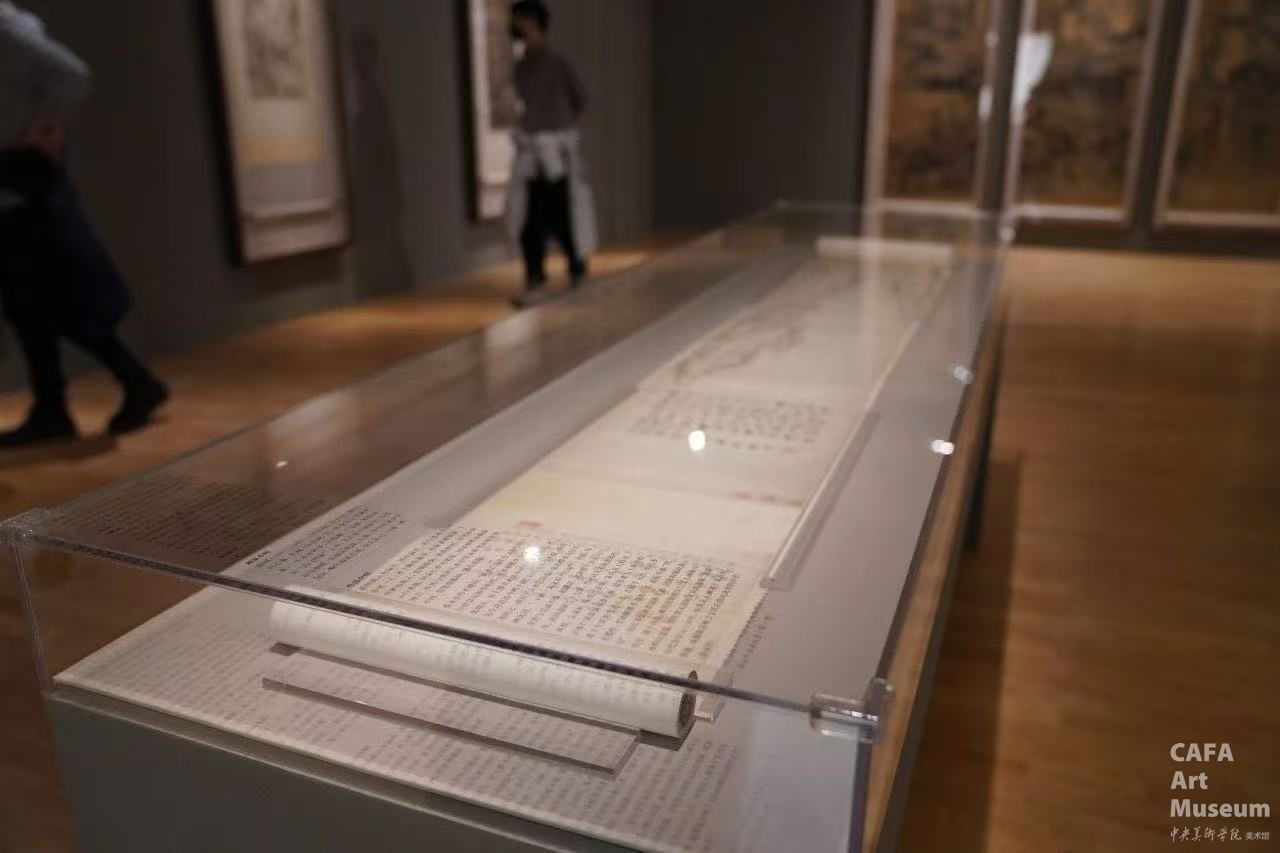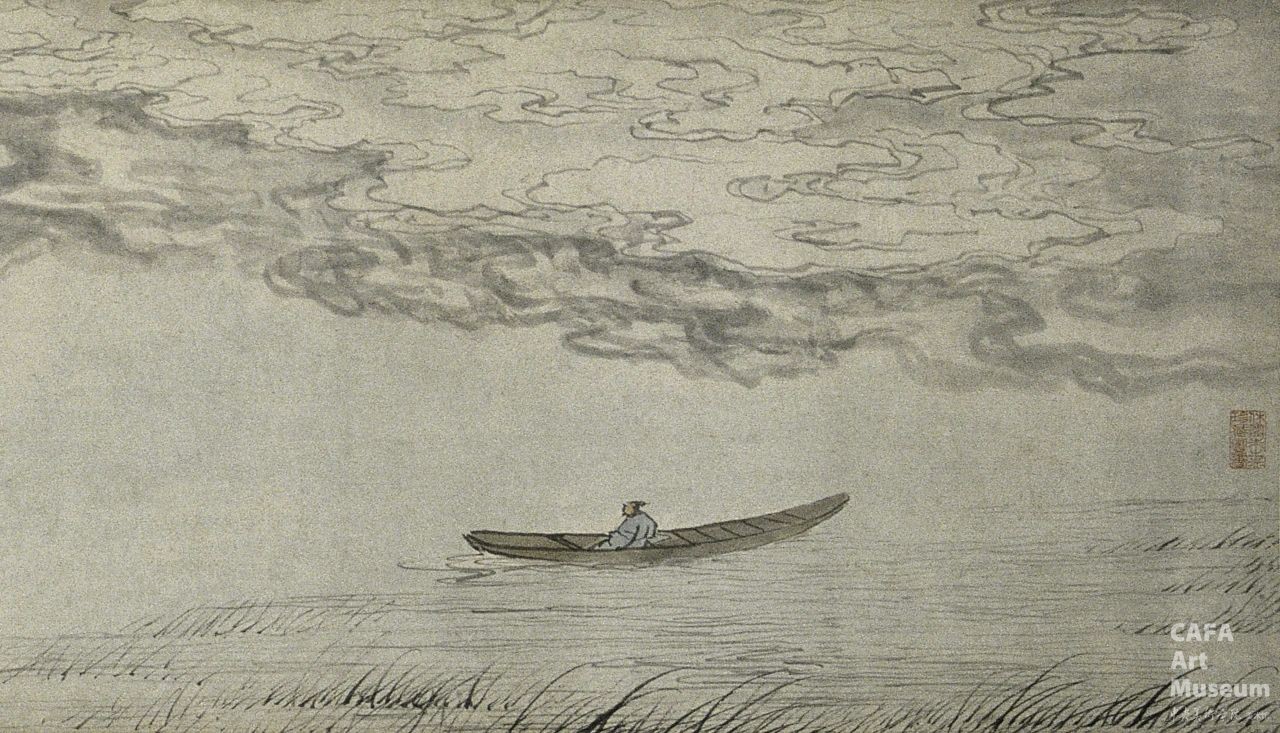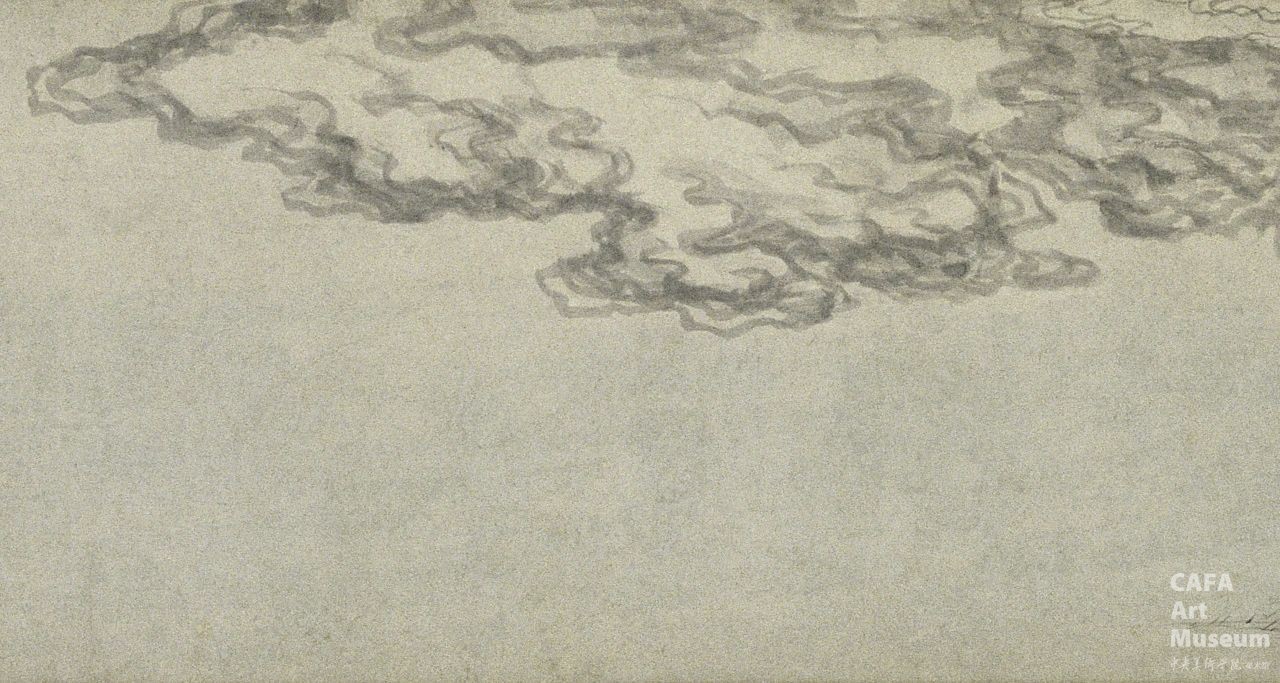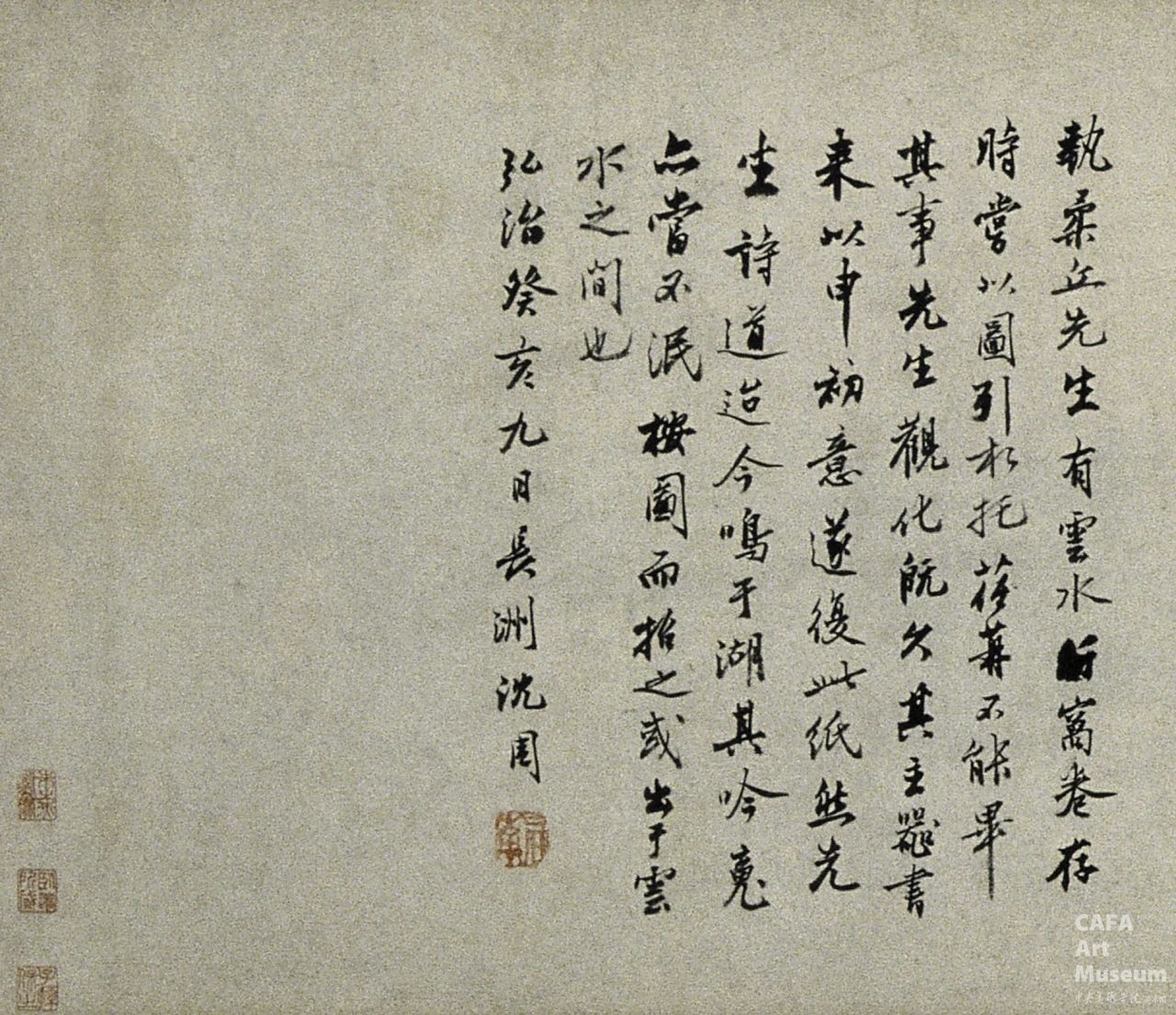

The exhibition "Collection Of CAFA Art Museum" is currently being held at the Art Museum of the Central Academy of Fine Arts. The part of ancient Chinese art presented this time is one of the characteristics of the museum's collection. More than 200 pieces of the collection have been selected and are exhibited in two major categories: "utensils" and "calligraphy and paintings". The time span covers two thousand years. This push article will lead the audience into the brushwork and spiritual world of the ancients through Shen Zhou's painting "The Picture of the Cloud and Water Abode". When you see with your own eyes the brushstrokes that spread out on the raw rice paper more than 500 years ago and stop in front of the spiritual "abode" built for you, sooner or later you will also fall in love with him!

Shen Zhou, The Picture of the Cloud and Water Abode, created in 1503, colored painting on paper, 33cm*164cm, collected by CAFAM
Shen Zhou (1427-1509), styled Qinan, pseudonym Shitian, and later known as Baishiweng, was from Changzhou (now Suzhou). He was born into a family with a background in poetry, calligraphy, and painting. Throughout his life, he never took the imperial examinations. He had a rich collection, made extensive friends, and was proficient in painting. Shen Zhou was the founder of the Wu School of Painting. Together with Wen Zhengming, Tang Yin, and Qiu Ying, he was known as the "Four Masters of the Ming Dynasty." In his early years, his landscape paintings inherited the family's artistic tradition and received guidance from Du Qiong and others. Later, he learned from Dong Yuan and Ju Ran. In his middle age, he followed the style of Huang Gongwang as his model. In his later years, he drew inspiration from Wu Zhen. His works combined elements of the Song and Yuan dynasties and formed his own unique style.
Shen Zhou's artistic creations have always been closely connected with nature. He declined the court's recruitment and chose to observe the changes of the four seasons at the "Youzhu Village" by the Taihu Lake, integrating his philosophical thoughts on time into his paintings. In his poems and paintings, there often shows "the deep sentiment of mourning the passing of time", yet he also cherishes the present moment with a sober attitude. This contradiction becomes the core of the charm of his art.
In his early years, Shen Zhou's works mainly featured fine brushstrokes, with a rigorous and meticulous style. After reaching middle age, he shifted to using thicker brushstrokes, integrating the vigorousness of the Southern Song Dynasty style with the freshness and smoothness of the Northern Song Dynasty style, and his brushwork was robust, powerful and rich in texture. He was proficient in incorporating the essence of calligraphic brushwork into his paintings, forming a unique artistic language characterized by "abundant brushstrokes and vigorous ink application".
In the painting "The Picture of the Cloud and Water Abode", a small boat sails on the water surface. There is a person sitting in the boat. There are slightly some cattail plants on the water. The lines depicting the folds of the clothes are vigorous, simple and concise. Dense flowing clouds cover the sky above. They are faintly tinted with ink, showing a gradation of shades from dark to light. The use of the brush is like the flowing of clouds and water. Sometimes, the brushwork of running and cursive scripts is interspersed. It twists and turns with pauses and reveals a hint of sharpness.

Partial View of The Picture of the Cloud and Water Abode
Shen Zhou used light ink to texture and dye the cloud layers, and dark ink to outline the contours of the mountains and rocks. He expressed the profoundness of the space through the contrast between dry and wet ink. The small boat was outlined with fine brushstrokes, and the lines of the figure's clothes were simple and concise. This formed a balance between movement and stillness with the hazy background, demonstrating his style in his later years, which was "bold and unrestrained in a rough and simple way" yet introverted and profound.

Partial View of The Picture of the Cloud and Water Abode
His style is different from the common appearance of thick brushstrokes often seen in Shen Zhou's landscape paintings. However, his brush and ink work is exquisite and full of artistic conception, creating a sense of tranquility in the "empty green space". His landscape paintings not only depict nature, but also convey the ideals of literati through the figures in the scenes. The people in the paintings are often placed in the "ideal landscape" where the real and the illusory coexist. It is both a projection of reality and an externalization of the spirit.

Partial View of The Picture of the Cloud and Water Abode
At the end of the scroll, there is the inscription by the author: "Mr. Zhi Rou Qiu had a scroll titled 'The Cloud and Water Abode'. When he was alive, he once entrusted me with the task of creating an illustration for it. Time passed by, and I couldn't complete it. Since Mr. Qiu has passed away for a long time, his heir sent a letter to remind me of his original intention, so I completed this piece of paper. However, Mr. Qiu's poetic talent still resounds around the lake up to now, and his poetic spirit should also not fade away. By looking at this picture and summoning him, he might appear among the clouds and water. On the ninth day of the ninth lunar month in the Guihai year of the Hongzhi Reign, Shen Zhou from Changzhou." Below the inscription, there is a vermilion seal with the character "Qinan". Both the calligraphy and the seal are no different from the authentic works. According to the textual research and study by Mr. Xue Yongnian, this painting was created in 1503 AD. Shen Zhou was seventy-seven years old by Chinese reckoning. It was painted at the request of the poet Zhu Zhi Rou. By the time it was completed, Zhu had already passed away. Mr. Xue believes that the identity of Zhu Zhi Rou remains to be verified, and "The Cloud and Water Abode" is the name of his study. Landscape paintings of studies, which take the study as the main body and depict the life of the study owner, emerged in the Yuan Dynasty and were often created in the Ming Dynasty. However, this painting is not a landscape painting of a study but an "illustration for the study", which is used to guide readers to visit the study. Therefore, the artistic conception is constructed with the virtual replacing the real, full of poetic flavor, which is highly in line with the unique artistic charm of the landscape paintings by the literati painters of the Wu School in the Ming Dynasty.
This painting bears four seal impressions of Zhu Zhichi, a collector from the late Ming Dynasty to the early Qing Dynasty, in vermilion characters. They are respectively: "Treasure Collection of Books by Zhu Zhichi of Xiuning", "To Be Treasured by Descendants", "Appreciation by Zhu Zhichi", and "Collected by Wo'an". The first two seals are no different from those commonly used by Zhu Zhichi, but they have not been recorded in the Catalogue of Calligraphy and Paintings Collected by Zhu Wo'an. There is also an inscription by Wen Congjian from the late Ming Dynasty to the early Qing Dynasty. The inscription reads: "Minister Dong commented on the paintings of the late Grand Historian, saying that the small works of the Grand Historian are of a quality that surpasses those of exquisite craftsmanship by several yojanas. The essence of the excellence lies within the brush and ink. As for the playful techniques, one should not seek them in terms of the appearance of horses. The same is true for Master Baishi. His large scrolls and high screens exude an aura that can engulf heaven and earth. Viewers feel as if they are facing Mount Lushan and Mount Tai and dare not look up directly. It is not as good as the depiction of a gentle stream, a faint moon, and idle clouds, which reveals the true face of nature. The wonder of this scroll is truly indescribable. I just want to sit and lie beneath it for three days. This inscription is written while recalling the poet by the lakeside, as if mourning Qu Yuan by the Xiang River. On the sixth day of the twelfth lunar month in the yimao year, I respectfully inscribe this in the Tingyun Pavilion while burning incense. Wen Congjian, a later scholar." At the beginning of the inscription, there is an oval seal impression of "Kaiyun Tower" (in white characters), and below the signature, there are seal impressions of "Seal of Wen Congjian" (in white characters) and "Yu Yanke" (in white characters). The inscription was written in 1539 AD, seemingly before the painting was collected by the Zhu family of Xiuning. This inscription reflects the evaluation of this painting by the descendants of the Wen family. This painting was once published in the Catalogue of Ancient Chinese Calligraphy and Paintings (Volume One). (The above interpretation of this work by Mr. Xue Yongnian is quoted from the Catalogue of the Special Exhibition of "The Artistic Conception and Craftsmanship: An International Academic Symposium on Ming and Qing Paintings", p21.)
It is worth mentioning that The Picture of the Cloud and Water Abode is currently on display in the exhibition hall on the third floor of CAFA Art Museum. Viewers who wish to see the original work with their own eyes are welcome to come and visit.
The information about the inscription and seal impressions of this work:
Inscription: Mr. Zhi Rouqiu had the scroll titled "Dwelling in the Clouds and Waters". When he was still alive, he once entrusted me with the task of creating an illustration for it. Time passed by, and I couldn't complete this task. It has been a long time since Mr. Zhi passed away. His heir sent me a letter, reaffirming his original intention. So I finally made this painting. However, Mr. Zhi's poetry is still renowned around the lake area up to now, and his poetic spirit should surely remain unforgettable. When pointing at this picture, one might imagine him appearing amidst the clouds and waters. On the 9th day of the 9th lunar month in the year of Hongzhi Guihai (1503), Shen Zhou of Changzhou.
Seal impression: Qinan (a square seal with characters in intaglio)
Colophon: Minister Dong commented on the paintings of the late Grand Historian as follows: "The Grand Historian's small works possess a quality that surpasses those that are exquisitely crafted." The subtlety of such masterful works lies within the strokes of the brush and ink. As for the artistry born out of spontaneous play, one should not seek to understand it merely by focusing on superficial aspects, just as one should not judge a horse solely by its color or gender. The same is true for the Elder of White Stone. His large-scale paintings on tall screens are so imposing that their aura seems to be able to engulf the heaven and earth. When viewers gaze upon them, they feel as if they are facing Mount Lushan or Mount Tai and dare not look up directly. It is not as good as the depictions of faint mountains, shallow waters, a slender moon, and idle clouds, which capture the true visage of nature. The wonder of this scroll is beyond description. I only wish I could sit or lie beneath it. After three days, I write these words, recalling the poet by the lakeside. It feels as if I am paying homage to Qu Yuan by the Xiao and Xiang Rivers. On the sixth day of the twelfth lunar month in the Jichou year, I burn incense and respectfully write this colophon in the Tingyun Pavilion. Wen Congjian, a junior scholar.
Seal Imprints: Kaiyun Tower (Zhuwen oval seal), Seal of Wen Congjian (Baiwen square seal), The Style Name is Yanke (Baiwen square seal)
Seal Imprints for Appreciation and Collection: Appreciated by Zhu Zhichi (Zhuwen square seal), Collected by Wo'an (Zhuwen square seal), To Be Preserved by Descendants (Zhuwen square seal)

Collection Of CAFA Art Museum
——Ancient Chinese Art
Exhibition Duration: Long-term Exhibition
Exhibition Venue: Gallery 2A, CAFA Art Museum
Chief Editor / He Yisha
Editor / Du Yinzhu
